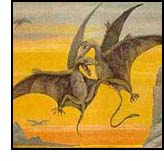
Pterodactyl was a small, flying reptile that lived during the time of the dinosaurs. It was not a dinosaur, but type of extinct, flying reptile.
Pterodactylus had a 2.5 to 3.1 foot (0.75 - 1 m) wide wingspan. It was lightly built, with hollow bones, a long, curved neck, a long skull (with no crest), a long, pointed beak, many small teeth, a small body, and a very short tail. It had a relatively large brain and good eyesight. The skull was about 2.4 inches (6 cm) long.
Pterodactyloid wings were covered by a leathery membrane. This thin but tough membrane stretched between its body, the top of its legs and its elongated fourth fingers, forming the structure of the wing. Claws protruded from the other fingers. Pterodactylus could flap its wings and fly with power.